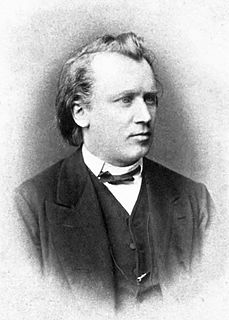In music theory, a scale is any set of musical notes ordered by fundamental frequency or pitch. A scale ordered by increasing pitch is an ascending scale, and a scale ordered by decreasing pitch is a descending scale. Some scales contain different pitches when ascending than when descending, for example, the melodic minor scale.
A pentatonic scale is a musical scale with five notes per octave, in contrast to the more familiar heptatonic scale that has seven notes per octave.
An octatonic scale is any eight-note musical scale. However, the term most often refers to the symmetric scale composed of alternating whole and half steps, as shown at right. In classical theory, this scale is commonly called the octatonic scale, although there are a total of 42 non-enharmonically equivalent, non-transpositionally equivalent eight-note sets.
Julius Baker was one of the foremost American orchestral flute players. During the course of five decades he concertized with several of America's premier orchestral ensembles including the Chicago Symphony and the New York Philharmonic Orchestra.

Tōru Takemitsu was a Japanese composer and writer on aesthetics and music theory. Largely self-taught, Takemitsu possessed consummate skill in the subtle manipulation of instrumental and orchestral timbre. He is famed for combining elements of oriental and occidental philosophy to create a sound uniquely his own, and for fusing opposites together such as sound with silence and tradition with innovation.

In music, a ninth is a compound interval consisting of an octave plus a second.
Children's Corner, L. 113, is a 6-movement suite for solo piano by Claude Debussy. It was published by Durand in 1908, and was first performed by Harold Bauer in Paris on 18 December that year. In 1911, an orchestration by André Caplet was premiered and subsequently published. A typical performance of the suite lasts roughly 15 minutes.

Gaspar Cassadó i Moreu was a Catalan cellist and composer of the early 20th century. He was born in Barcelona to a church musician father, Joaquim Cassadó, and began taking cello lessons at age seven. When he was nine, he played in a recital where Pablo Casals was in the audience; Casals immediately offered to teach him. The city of Barcelona awarded him a scholarship so that he could study with Casals in Paris.

G-flat major is a major scale based on G♭, consisting of the pitches G♭, A♭, B♭, C♭, D♭, E♭, and F. Its key signature has six flats.

Star Gazers is a five-minute astronomy show on American public television previously hosted by Jack Foley Horkheimer, executive director of the Miami Space Transit Planetarium. After his death in 2010 from a respiratory illness from which he had suffered since childhood, a series of guest astronomers hosted until 2011, when Dean Regas, James Albury, and Marlene Hidalgo became permanent co-hosts. On the weekly program, the host informs the viewer of significant astronomical events for the upcoming week, including key constellations, stars and planets, lunar eclipses and conjunctions, as well as historical and scientific information about these events.
"Beau Soir" is a French art song written by Claude Debussy. It is a setting of a poem by Paul Bourget.
Estampes ("Prints"), L.100, is a composition for solo piano by Claude Debussy. It was finished in 1903.
Jack Horkheimer was the executive director of the Miami Space Transit Planetarium. He was best known for his astronomy show Jack Horkheimer: Star Gazer, which started airing on PBS on November 4, 1976.

Diatonic and chromatic are terms in music theory that are most often used to characterize scales, and are also applied to musical instruments, intervals, chords, notes, musical styles, and kinds of harmony. They are very often used as a pair, especially when applied to contrasting features of the common practice music of the period 1600–1900.
La Cathédrale engloutie is a prelude written by the French composer Claude Debussy for solo piano. It was published in 1910 as the tenth prelude in Debussy’s first of two volumes of twelve piano preludes each. It is characteristic of Debussy in its form, harmony, and content.

Snowflakes Are Dancing is the second studio album by Japanese musician Isao Tomita, recorded in 1973–1974 and first released by RCA Records as a Quadradisc in April 1974. The album consists entirely of Tomita's arrangements of Claude Debussy's "tone paintings", performed by Tomita on a Moog synthesizer and a mellotron. It entered the top 50 charts in the United States, where it was nominated for four Grammy Awards in 1975, including best classical album of the year, and it was NARM's best-selling classical album of the year. In Canada, it reached #57 in the RPM Magazine Top Albums chart.

The Piano Quartet No. 3 in C minor, Op. 60, completed by Johannes Brahms in 1875, is scored for piano, violin, viola and cello. It is sometimes called the Werther Quartet after Goethe's The Sorrows of Young Werther.
La fille aux cheveux de lin is a musical composition for solo piano by French composer Claude Debussy. It is the eighth piece in the composer's first book of Préludes, written between late 1909 and early 1910. The title is in French and translates roughly to "The Girl with the Flaxen Hair". The piece is 39 measures long and takes approximately two and a half minutes to play. It is in the key of G♭ major.
Mimi Stillman is a prominent concert flutist. She has been hailed by The New York Times as "a consummate and charismatic performer." Called "the coolest flute player" by Philadelphia Magazine. A Yamaha Performing Artist, she has appeared as soloist with orchestras including The Philadelphia Orchestra, Bach-Collegium Stuttgart, Hilton Head Orchestra, Indianapolis Chamber Orchestra, Orquesta Sinfónica de Yucatán, Orquesta Sinfónica Carlos Chávez, Oklahoma City Philharmonic, Orchestra 2001, Ocean City Pops, Spartanburg Philharmonic Orchestra, Chamber Orchestra of the Triangle, and Curtis Chamber Orchestra. She has appeared as recitalist and chamber musician at The Kennedy Center, Carnegie Hall, the Kimmel Center for the Performing Arts, Philadelphia Chamber Music Society, Bard College, La Jolla Chamber Music Society, Kingston Chamber Music Festival, Isabella Stewart Gardner Museum, Bay Chamber Concerts (ME), Verbier Festival (Switzerland), Israeli radio Kol HaMusica, National Sawdust, Roulette, and Festival delle Nazioni (Italy).















